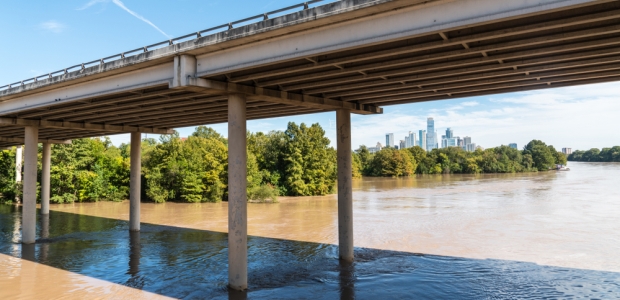
Tool Helps Measure Bridges' Safety After Severe Storms
"After powerful storms come through, being able to quickly assess whether or not key transportation infrastructure can hold heavy trucks that deliver relief aid is vital," explained Eleanore Hajian, the DHS S&T program manager responsible for the Soil Probe project.
A project supported by the U.S. Department of Homeland Security's Science and Technology Directorate has developed an instrument that can quickly assess the soil conditions around bridge pillars, and an accompanying standard to be released this fall proves the viability of the technology, the directorate announced Nov. 13. Hurricanes and heavy rains often cause strong, overflowing river currents that can damage critical infrastructure such as bridges, S&T noted, citing the example when, after Hurricane Katrina, many National Guard convoys loaded with aid did not drive on bridges for fear the bridges could not support the heavy trucks.
The result of the project, conducted by DHS S&T's Coastal Hazards Center of Excellence, is the In-situ Erosion Evaluation Probe, also known as Soil Probe. It needs only chargeable batteries to drive the water pump; the probe is made up of a stiff cylinder and a pump that uses the water surrounding the bridge to jet away soil and sink the probe deeper.
"After powerful storms come through, being able to quickly assess whether or not key transportation infrastructure can hold heavy trucks that deliver relief aid is vital," explained Eleanore Hajian, the DHS S&T program manager responsible for the Soil Probe project.
"The strength of the bridge is dependent on how strong the soil is," said Dr. Mohammed Gabr, a Distinguished Professor of Civil Engineering and Construction at North Carolina State University who developed the Soil Probe. "This device can be used in places where taking samples is not feasible," he said. "The testing is rapid—it can go 30 feet deep within five minutes—and can be done in many places along a bridge for a complete mapping of the bridge foundation support area. The most time-consuming part is driving to the site."
"How fast the soil washes away depends on how strong the soil is," he said. "The probe would bury itself quicker in soft soil compared to strong, compact soil."
Gabr and his team developed a prototype they tested in the lab and in the field. The last test was in 2016, after Hurricane Irene opened a new inlet on Pea Island in the Outer Banks, N.C. "The Department of Transportation was putting a temporary bridge over the new inlet," he said. "After we tested, we confirmed the soil was safe for a permanent bridge."
Gabr wrote the standard with instructions on how to make and use the Soil Probe for the ASTM International.
Currently, it takes a long time to determine the stability of bridge pillars. Engineers take core samples with heavy and expensive equipment, and several hours or days are required for the results to be ready. For sand samples, scientists would pour expensive liquid hydrogen to freeze the ground so the sand’s original structure was preserved. These limitations helped inform the requirements for the Soil Probe device, including minimal dependence on power and easy operation by two people. With this device, there is no need to gather samples for laboratory testing to assess the soil resistance to erosion.